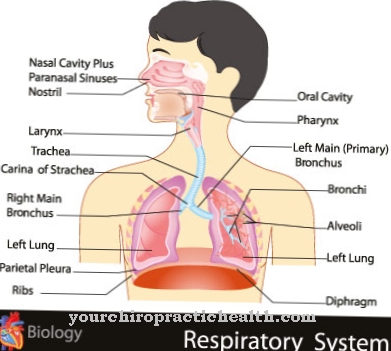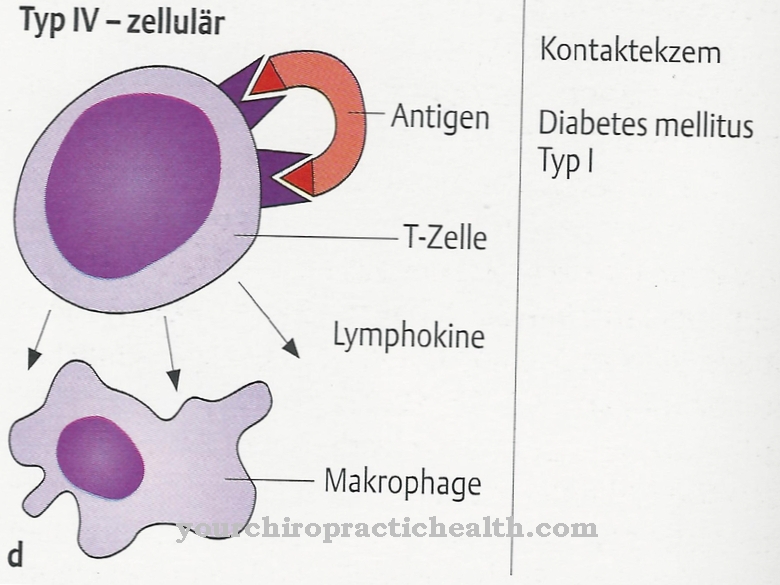As β-oxidation defect or Fatty acid oxidation defect is the name given to a congenital metabolic disorder that occurs frequently in Central Europe. If the β-oxidation is disturbed, not enough energy is produced. If the consumption of glucose increases and the blood sugar level drops as a result, the synthesis of ketones is also reduced. In addition to symptoms such as muscle weakness and cardiac arrhythmias, the resulting energy deficit also results in an insufficient supply of the brain. If left untreated, this can lead to brain damage or, in the worst case, death.
What is a β-Oxidation Defect?
In order for organisms to live, they have to absorb energy and process it in the body. The metabolism of carbohydrates, fats and proteins takes place in different ways. The energy-rich dietary fats are first broken down in the digestive tract and transported via the blood into the body cells and stored there.
The body mainly uses these deposits when the energy can no longer be provided from carbohydrates, for example during periods of hunger or increased energy requirements. So that the energy can be released and used, the free fatty acids are transported via transporters (e.g. L-carnitine) to the cells' power stations, the mitochondria. The multi-stage degradation process is called β-oxidation.
The fatty acids are broken down step by step with the help of various enzymes and finally introduced into the citrate cycle in order to provide the body with ATP, the universal and immediately available energy source, as the end result. Depending on the type of fatty acid (medium or long-chain), different enzymes are responsible for the oxidation.
If there is now a deficiency in this special enzyme in the body, the breakdown of the fatty acid is disturbed - it comes to one β-oxidation defect. The metabolic intermediate products remain in the cells, cannot be further processed or transported away and thus develop a toxic effect on the brain, muscles and liver in a short time.
causes
The cause of these metabolic disorders are either congenital enzyme or transporter defects or a so-called secondary carnitine deficiency. This deficiency can in turn be caused by primary illnesses (disorders in the metabolism of amino acids), or it can also occur with certain forms of treatment of epilepsy, manifest during dialysis or develop through persistent malnutrition.
Symptoms, ailments & signs
Depending on the enzyme defect, different symptoms appear. These are triggered by a metabolic crisis as a result of a lack of energy supply. The fat metabolism usually provides up to 80 percent of the total metabolic energy. Heart and skeletal muscles in particular are dependent on the provision of energy from fatty acid oxidation.
If there is a defect, more glucose is broken down instead, which can lead to massive hypoglycaemia and even coma after about twelve hours in this state. Often the symptoms appear in the first few months of life. Affected infants show an enlarged liver and periodically low blood pressure, abnormalities in cardiac activity up to and including heart and organ failure.
If left untreated, there is a high risk of death. Hypoglycemia and diseases of the liver can be observed in later forms in children and adolescents. Those affected in the late-onset form commonly suffer from muscle pain and cramps as well as periodic kidney failure.
Often there is also a pronounced exercise intolerance. When beta-oxidation of long-chain fatty acids is disturbed, the lack of omega-3 fatty acids leads to a reduced development of visual and cognitive functions.
Diagnosis & course of disease
For the diagnosis of metabolic defects, tandem mass spectrometry has become firmly established in the context of newborn screening and, as a non-invasive diagnostic method, is also the current standard of investigation. Here, the enzyme activity in blood serum, skin cells, muscle tissue or even in the affected gene itself is determined. If the symptoms do not appear until children and adolescents, diagnosis is often made more difficult by the fact that the patient was previously clinically completely normal.
Since a metabolic crisis develops into a coma if left untreated, there is a high risk of death if the cause is not known. If, on the other hand, the disease is detected early, most cases can be treated very well. Exceptions here are a few difficult cases, in which life expectancy is comparatively lower due to permanent disease of the heart muscle.
When should you go to the doctor?
With this disease, the person affected is dependent on a visit to a doctor. As a rule, it cannot heal independently, so treatment by a doctor is definitely necessary. The earlier a doctor is consulted in the case of a Β-oxidation defect, the better the further course of this disease is, so that a doctor should be contacted as soon as the first symptoms and complaints appear. A doctor should be contacted if the person concerned has very severe heart problems.
In most cases, the disease makes people repeatedly unconscious and have low blood pressure. In particular, strenuous or stressful activities and activities can lead to a loss of consciousness or even to a coma and should therefore always be examined by a doctor. Even severe pain in the muscles often indicates a Β-oxidation defect if it occurs over a longer period of time and does not go away on its own. As a rule, the disease can be easily recognized by a general practitioner.
Treatment & Therapy
In the event of an acute metabolic crisis, immediate medical treatment is essential. The treatment is carried out by infusion with glucose, in the case of primary carnitine deficiency in children with high-dose L-carnitine. In severe cases, continuous feeding of high-dose carbohydrates via a gastric tube is possible.
prevention
Since the disease is congenital, there are no preventive measures. However, a targeted diet can make a significant contribution to avoiding metabolic crises and thus hypoglycaemia and preventing a fast-induced coma. For this, you should ensure that you eat a regular high-carbohydrate diet.
The proportion of carbohydrates should be between 55 to 60 percent of the energy intake, depending on the form of the oxidation disorder with 20 to 25 percent fat. Rice flakes are recommended for older infants and cooked cornstarch as a food additive for small children. Long periods of fasting, so-called hunger phases, should be avoided and should not last longer than ten to twelve hours for adolescents.
If there is a deficit of omega-3 fatty acids, which affects the development of visual and cognitive functions, a substitution with fish oil preparations is recommended. In general, if you notice the first signs of hypoglycaemia in yourself or a third party, it is advisable to give food containing sugar, preferably glucose or sweet drinks. However, foods that are high in fat should be avoided. In case of doubt, a doctor should be consulted.
You can do that yourself
Patients with this disease must first be examined whether the Β-oxidation defect is based on a disease that can be treated. Most of the time, however, the metabolic disorder is innate and can become a major burden, since deficiency situations lead to metabolic crises and can be fatal.
It is therefore important to avoid any possible hypoglycaemia. In their diet, patients should make sure that they eat foods that are very high in carbohydrates, such as bread, pasta, potatoes, rice, rice flakes, corn starch, fruit, glucose, sweet drinks, etc. In addition, patients should eat very regularly. In order to avoid a state of fasting, one should eat high carbohydrates every few hours. How high the fat content of the diet should be at the same time is determined by the attending physician, depending on the severity of the Β-oxidation defect.
The doctor may also recommend that patients substitute omega-3 fatty acids if they are deficient. There are now quite inexpensive fish oil capsules on the market. A Β-oxidation defect is not a very common disease, so no special self-help groups have been formed here. However, there is the Association for Association for Congenital Metabolic Disorders e.V. (VfASS) in Berlin (www.vfass.de), through which members can exchange and inform themselves. Such an exchange has proven to be helpful for those affected, especially with such rare and at the same time life-threatening diseases as the Β-oxidation defect.






.jpg)

















.jpg)



